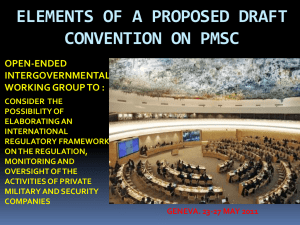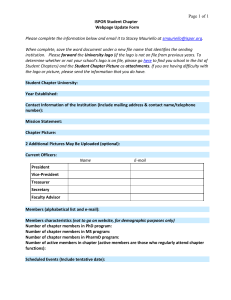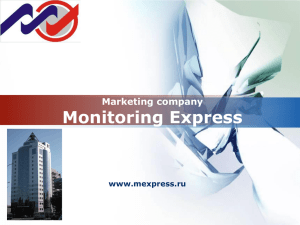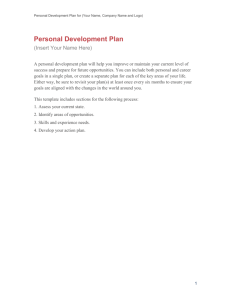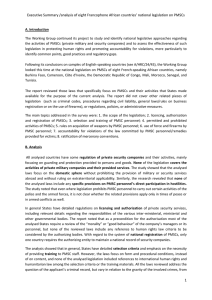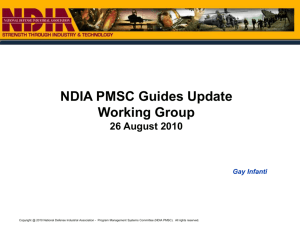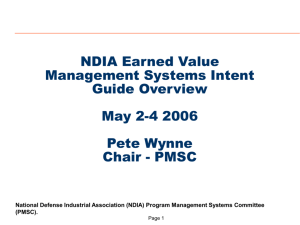Application of LOGO-environment for children`s creative work
advertisement
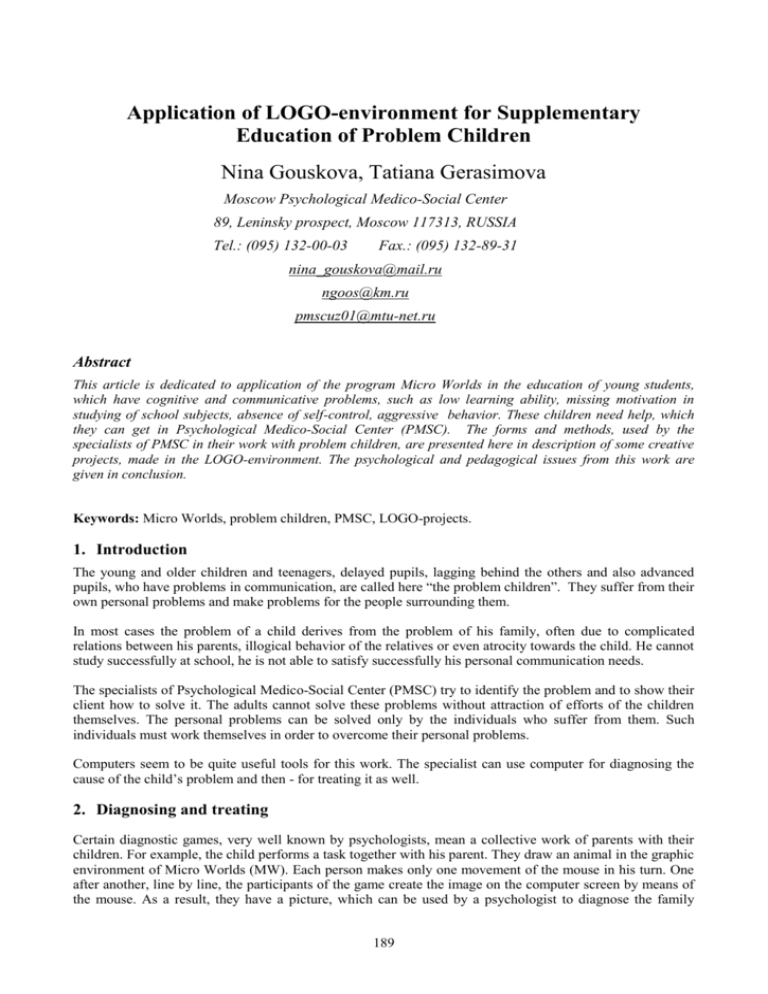
Application of LOGO-environment for Supplementary Education of Problem Children Nina Gouskova, Tatiana Gerasimova Moscow Psychological Medico-Social Center 89, Leninsky prospect, Moscow 117313, RUSSIA Tel.: (095) 132-00-03 Fax.: (095) 132-89-31 nina_gouskova@mail.ru ngoos@km.ru pmscuz01@mtu-net.ru Abstract This article is dedicated to application of the program Micro Worlds in the education of young students, which have cognitive and communicative problems, such as low learning ability, missing motivation in studying of school subjects, absence of self-control, aggressive behavior. These children need help, which they can get in Psychological Medico-Social Center (PMSC). The forms and methods, used by the specialists of PMSC in their work with problem children, are presented here in description of some creative projects, made in the LOGO-environment. The psychological and pedagogical issues from this work are given in conclusion. Keywords: Micro Worlds, problem children, PMSC, LOGO-projects. 1. Introduction The young and older children and teenagers, delayed pupils, lagging behind the others and also advanced pupils, who have problems in communication, are called here “the problem children”. They suffer from their own personal problems and make problems for the people surrounding them. In most cases the problem of a child derives from the problem of his family, often due to complicated relations between his parents, illogical behavior of the relatives or even atrocity towards the child. He cannot study successfully at school, he is not able to satisfy successfully his personal communication needs. The specialists of Psychological Medico-Social Center (PMSC) try to identify the problem and to show their client how to solve it. The adults cannot solve these problems without attraction of efforts of the children themselves. The personal problems can be solved only by the individuals who suffer from them. Such individuals must work themselves in order to overcome their personal problems. Computers seem to be quite useful tools for this work. The specialist can use computer for diagnosing the cause of the child’s problem and then - for treating it as well. 2. Diagnosing and treating Certain diagnostic games, very well known by psychologists, mean a collective work of parents with their children. For example, the child performs a task together with his parent. They draw an animal in the graphic environment of Micro Worlds (MW). Each person makes only one movement of the mouse in his turn. One after another, line by line, the participants of the game create the image on the computer screen by means of the mouse. As a result, they have a picture, which can be used by a psychologist to diagnose the family 189 problem or to discover the child’s personal problem. If the pictures of the participants of the game are, for example, separated (two different animals in the opposite corners of the screen) – you can make a conclusion, that there is no contact between the child and his parent. Otherwise, if the child makes a good team with his parents, we can see a completed colorful design as a result of their work. If the child always follows the actions of his parent and does not display his own fantasy or initiative (if he, for example, fills by color the frame or continues the line, made by his parent) – you can talk about dependence of the child from his parent. It may be good or not, all depends on the situation. But any way, you should pay attention and be careful. The missing independence can grow in a real personal problem. And so on. This game can also be used for treating the problem, for example – for making the parents to turn themselves towards the problems of their child, or for making the child to trust his parents. This gives the both sides a chance to understand each other. The main result of this work of the specialists of PMSC is improvement of psychological situation in the families of about 200 problem children each year. 3. Classes of supplementary education The practice of our center includes the lessons with the schoolchildren from the nearest schools. The specialists of PMSC work with different grades: the age of students is from 7 to 16 years. It functions as follows. The psychologists and the teachers of the PMSC, together with the parents of “the problem children” or with the school teachers organize the classes of supplementary education. The students come to the PMSC with their teacher and have lessons of drawing and animation in the computer class. They perform some amusing work, that is rather popular in the children’s and teenagers’ circle. This activity helps to wake up the learning and creative abilities of the students and to raise their motivation in studying of school disciplines. In order to develop the first skills of graphic work the students perform such sort of task: they make with the help of computer a holiday post card for their parents, or grand-parents, brothers and sisters, or their favorite teacher or their class-mates. This work is not very difficult, but it can be very useful in moral plan. It can become a small step to re-establish the broken relations. It can make others remark on the successful work of these students as well. It should be noted, that the students of these groups are not very successful in studying at school. Some of them are nervous, the others are too slow and depressed. Some students are sufficiently bright in studying of school sciences, but through their disturbed behavior they are behind the rest of their class. The others have real problems with education because of the limited learning capacity. Due to the supplementary correctional course, these children have more possibilities to finish successfully their secondary education. 4. LEGO – LOGO One more sort of useful work for our students is making models and constructions. The students create their play-environment with LEGO. We use LEGO duplo for the younger students and LEGO technic for the older ones. Operating with the small blocks lets to develop the movements of fingers, which is rather important for the schoolchildren. Teenagers work with ControlLab, making computer programs to control electro-mechanical Lego-models. The latter requires the real scientific abilities of the students, so they become those abilities by working. Here is an example of Lego-project for the 10-14 aged students. The name of the project is: 190 “The Naval Battle” (Lego-project) The children are to make electro-mechanical Lego-models of ships. The task is: organize the dialogue between the ships, using the Morse alphabet. While organizing the dialogue between the participants of the game the students use the ControlLab program environment. For the beginning the students program the SOS-signal in Morse alphabet with the help of Logo-commands in ControlLab. It looks like this: /– – –/ // /– – –/ // Consequence of points and dashes is presented by light- and sound-signals of a lamp and a sound-element. The Logo-program is not very difficult: to Morse repeat 3 [tto [lampa soundb] onfor 1 wait 1] wait 1 repeat 3 [tto [lampa soundb] onfor 2 wait 1] wait 1 repeat 3 [tto [lampa soundb] onfor 1 wait 1] wait 3 end In order to send several times the SOS-signal, we must repeat this procedure, for example: repeat 100 Morse The game with using Morse alphabet coding and conversation can be very exciting. 5. Micro Worlds projects The program Micro Worlds gives the students large possibilities to get acquainted with the Logoenvironment and to use it for their creative work. It proves to be useful for school-children of different grades to apply Logo-means to perform their computer-projects in certain school-subjects. Some sorts of projects, realized by the pupils of 10-13 years old, were demonstrated on the “EUROLOGO’99” Conference. Now we’d like to present some new projects in the same style. Project 1. “Living books”. The task is: 1) Type the text of the story; 2) Illustrate it and animate the pictures using the means of MW. The story is divided in some parts, each student elaborates his personal part of the project. He types the text, draws the pictures and makes the programs in Logo to define the roles of turtles, who are the role-players of the story. After that the parts are to be assembled to become a whole story, performed as a “living book”. The common work requires the participants to be “professionals”, that is to know the subject well and to collaborate efficiently. Then they are to respect the opinion of each other and to be tolerant to the actions of each other. They become more sociable. Project 2. “Living songs”. The task is: 1) Type on computer the text of the song; 191 2) Perform it by the voice and record it on the disk in the MW-environment; 3) Illustrate it by the graphic means of MW-environment; 4) Animate the illustration with the help of the turtles in accordance with the rhythm and the sense of the song. This project is a bit different from the preceding one. The most interesting feature of it is that it can reflect brightly the emotional state of the pupil (or the group of pupils). As it is said in one lovely Canadian kid’s song: You gotta sing, when your spirit says “sing”… You gotta shout, when your spirit says “shout”… When your spirit says “shout”, You gotta shout right out loud, You gotta shout, when your spirit says “shout”. This sort of work is the way to provoke self-expression of the personality of the young participants, their behavior becomes natural. It’s their way to get free of stress and stop suffering. Project 3. “Games”. The task is: create your own computer game by the means of MW. This work includes graphic and programming. It requires from the students such qualities as creativity and patience. As a rule the children know a lot of computer games and play them with pleasure. They often compete with one another to find out who plays better. But it is fully another thing for the young author – to play his own game and to compare it with the works of his classmates. It’s another level of competition. The students find out whose invention is better. They demonstrate their active position. They develop their interest and motivation in the learning process. 6. Conclusion Creative work develops the cognitive and communicative abilities of children and teenagers. Each pupil is proud of his creation, he is glad to show it to his classmates, friends and parents. It is quite important for self-consideration and self-esteem and for self-education of the young person. It helps him to develop his personality harmoniously. The program Micro Worlds helps the teachers to develop the logical mind, attention and memory (which are in fact the main components of the learning ability) of their students. The important distinguishing feature of the teaching process for children is its emotional quality. The child remembers things, which are wonderful for him. So let’s make the world colorful and wonderful for our students. At school there is much theoretical information to be memorized. We can try to transform a considerable part of theoretical knowledge into visual and touchable form in order to make memorizing more creative and less passive. Learning by doing – it’s a good formula of Logo-philosophy, proposed by Seymour Papert . References Gouskova N, Ostrovskaya M (1999) Application of Logo Environment for Children’s Creative Work. Proceedings of the Seventh European Logo Conference “EUROLOGO’99” Sofia, BULGARIA. Kroupenin A, Krohina I (1995) Efficient Teacher. Practical Psychology for Teachers. “Phenix”, Rostov-na-Donu, RUSSIA. Kouzin V.S. (1997) Psychology. “AGAR”, Moscow, RUSSIA. Learning & Exploring with Logo (1997). Proceedings of the Sixth European Logo Conference “EUROLOGO’97”. Budapest, HUNGARY. 192 Logo Philosophy and Implementation (1999). Logo Computer System Inc. USA Robert Bayard, Jean Bayard (1981). Your troublesome teenager. Practical tutorial for parents. USA 193
